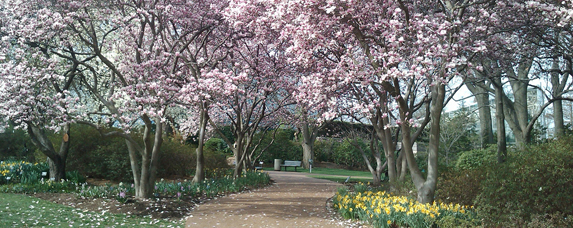
Magnolia trees, Magnolia spp., are a dramatic flowering tree. Most have large, cup-like flowers that open before the leaves are present. A gorgeous presentation of the purple-tinged saucer magnolias, Magnolia x soulangeana, can be found in the Kiefer Magnolia Walk, which connects the Linnean House to the Climatron.
 Magnolias are the defining genus of an entire order of plants, the Magnoliales. The magnolia is especially interesting as it is an example of a flower that arose early in the evolution of flowering plants, and has persisted through the eons.
Magnolias are the defining genus of an entire order of plants, the Magnoliales. The magnolia is especially interesting as it is an example of a flower that arose early in the evolution of flowering plants, and has persisted through the eons.
The first magnolias to break out on the spring scene are usually the star magnolias, Magnolia stellata. These medium-sized shrubs flaunt their airy white flowers before their leaves appear, sometimes as early as the third week of March and through the end of April. The star magnolia can be at risk to damage by frost if its buds open during a warm spell in early March.
During the months of May and June, the sweet bay, Magnolia virginiana, and the southern magnolias, Magnolia grandiflora, display their large, cup-like flowers. The southern magnolia cultivar 'Bracken’s Brown Beauty' is an evergreen magnolia that produces five-inch wide, creamy white spring flowers and is can be grown in the St. Louis area. The sweet bay magnolia, with its scented white blooms, is also suited for the St. Louis climate, but often loses its leaves in the winter. Numerous examples can be found on Garden grounds, especially in the Cherbonnier English Woodland Garden, including the Plant of MeritTM 'Jim Wilson' MOONGLOW.
Visitors can view a magnolia native to Missouri in the English Woodland Garden. The cucumber tree, Magnolia acuminata, is a deciduous tree that often produces good fall color (in contrast to its green spring flowers). Missouri-native tulip trees, Liriodendron tulipifera, are also members of the magnolia family.
In total, the Garden cultivates over 250 magnolia specimens. Magnolia blooms will be abundant throughout the Garden from the latter part of March (early magnolias are very vulnerable to spring frost) through the second week of June. The saucer and star magnolias will predominant in April with the southern magnolia following in June. Visit the Missouri Botanical Garden this spring to see these flowers that have been frozen in time, yet remain vibrantly alive.